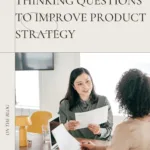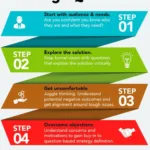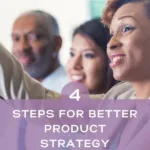Using critical thinking questions to improve product strategy
Last updated on May 14th, 2023 at 12:59 pm

One of my favorite stories about critical thinking questions in product management comes from a fellow product strategist. Earlier in his career, his boss brought a strategy document to the table for review. He asked his whole team to review it. They read through it all, and told the boss, “Looks great.” He looked around the table and said, “Not one question? I should fire all of you.”
While extreme, the boss was right on. If you aren’t asking critical thinking questions, the simple fact is, you aren’t thinking. As product managers, we are paid to think. This is our value to our companies. We must think of the customer, partner, and investor or owner perspective at a minimum. We can’t afford NOT to think because it can mean the difference between success and failure.
We can’t afford NOT to think, because it can mean the difference between success and failure.
– Julie Cabinaw

If you’ve ever been faced with the blank page staring back as you try to articulate a new strategy or product, do yourself a favor, and start by answering some critical thinking questions. You’ll find it much easier to build your strategy starting with questions first.
What questions should you be asking? While every situation will differ, there are some basics to start with. These questions are not an exhaustive list, but should get you thinking about your business and what additional questions you may need to ask beyond these that are specific to your situation.
Critical Thinking Questions about your audience and needs
It hopefully goes without saying, but as a product leader, you must be able to articulate who would use your solution and why it meets a need they have. Asking these critical thinking questions NOW can save your company a misfire later.
- What data do we have about this customer?
- How do we know this is the right customer?
- What else do we know about this customer that could influence this strategy?
- What is the biggest problem we are solving for this customer?
- Have we talked to any specific customers like this about this problem?
- What evidence do we have that this is actually a problem for this customer?
- What about this will excite a customer?
- What about this might disappoint a customer?
Explore the solution
Getting alignment on why you are doing this, right now, and how it fits with your overall strategy is very important. These critical thinking questions are designed to stop tunnel vision. It can also help you in the (unfortunately not-so-rare) event you’ve been assigned to create a solution that appears to be looking for a problem.
- Why is this important right now?
- How does this fit into the overall brand experience?
- How will this raise the bar for the customer experience?
- Are we first to market or following? How does that affect the opportunity?
- What other solutions to this problem have we considered?
- How will we measure success? (Lag measures)
- What are the early indicator measures that will let us know we are on the path to success? (Lead measures)
Get uncomfortable
This is where things start to get a little more tense. You’re just starting to love your new solution idea. And now you need to turn it inside out to ensure that you really understand it from all angles.
- Who in the organization have we talked to about this potential solution?
- Who do you expect not to like this strategy? Why?
- Is this as simple as it could be? If not, why not?
- What are the “dogs not barking”? (These are the things people may not want to talk about because it could reduce support for the strategy)
- What’s the worst outcome that could happen if we do this? How do we prevent that from happening?
- What are the potential trustbusters? (These are assumptions we may be making about conditions we believe customers, partners or internal stakeholders will accept, but we don’t know if they will)
- Do we need change management?
- Are there any other contingencies or assumptions we are making that would be necessary for this to work?
Overcome objections
You may get pushback when you try this approach. To deal with it, you have to understand the source of the concerns and how to address them.
Concern #1: I already know the answers to these questions.
“That’s great! We should have a lot of work done then. Let’s double-check to make sure we’re all in agreement.”
This sort of objection can come from a very positive place, where one or more stakeholders really does have a solid understanding of where you need to go with the strategy, or it can come from a place of one person having a vision, but perhaps not everyone sees it yet. Going through the critical thinking questions can illuminate alignment issues that otherwise may come to light too late.
Concern #2: This will take too long. We don’t have time for all of this.
“It should only take us a little time to slow down and think this through. How about I set up a couple of hours for us? I’ll take notes.”
This may be symptomatic of an organization or team members who like to follow their gut or is afraid to hear what the answers to critical thinking questions may be. They may be very invested in the solution and concerned that digging in may slow you down or perhaps even derail you from bringing a solution to market. Use your best judgment to understand and address underlying motivation.
Concern #3: Just fill out the template we have. We have it all there – summary, objectives, measures, etc.
“We do and it’s great! This will help us better complete the template thoughtfully. I find a lot of time, people get focused on output, and I would like to make sure our strategy focuses on outcomes.”
How many times have you seen a template filled out with the briefest of explanations just because someone felt like they had to check off a box? Developing a new strategy or solution is not the time to phone it in.
Don’t get me wrong, I have a template I ask my teams to fill out that has this great stuff too; but this will make filling out the document easier and help others internalize the strategy much better. The value is in the thought process.
This may be hard at first, but over time you will raise the bar on critical thinking in your product management organization. You may even find, over time, that these questions become the most valued part of your process.
Have you tried this approach in your organization or team?
Share your experiences in a comment below.








